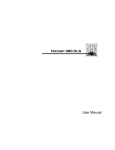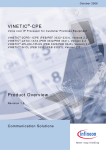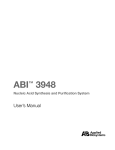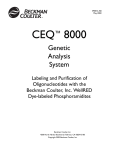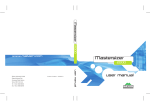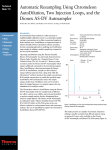Download Technical Bulletin
Transcript
22825 DAVIS DRIVE STERLING, VIRGINIA 20164 Suggested Laboratory Practices to Prevent Precipitation of dG Phosphoramidite PHONE 703-437-6191 800-327-GLEN FAX 703-435-9774 INTERNET WWW.GLENRES.COM FIGURE 1: dG PRECIPITATION ROUTE Introduction The doubly hydrolyzed form of deoxyguanosine phosphoramidite (Fig. 1) is insoluble in acetonitrile. This compound occasionally forms while the phosphoramidite solution is resident on automated nucleic acid synthesizers. While it is not harmful to the oligonucleotide, the precipitate can obstruct delivery lines and inhibit reagent flow. Unfortunately, precipitation occurs unpredictably, and as yet our chemists have been unable to reproduce the conditions that causes it. The problem is neither related to specific lots of bulk phosphoramidite, nor to specific sizes or lots of the packaged product. It cannot be linked to the concentration of the solution, nor does the method, autodilution or manual, of reconstitution appear to matter. It is also unrelated to the manufacturer of the phosphoramidite itself. Phosphoramidites are highly hygroscopic, readily absorbing water that may be present only in trace amounts. Of the four nucleosidic phosphoramidites, the guanosine salt is the least soluble. The others typically remain in solution where they can do no harm. Acetonitrile is similarly hygroscopic. We have demonstrated that an undisturbed open bottle of anhydrous acetonitrile (<30 ppm) can absorb enough water through its argon blanket to reach >200 ppm in less than 20 minutes. While our quality control, manufacturing, and research staff have not been able to reproducibly cause the precipitation, they have identified the precipitate and postulated the reaction pathway to it. This double hydrolysis is a slow process that may commence with a trace of atmospheric water absorbed by the dry powder. Precipitation may not occur until after acetonitrile is added. With this in mind, we have taken steps to eliminate exposure of all phosphoramidites to water at each phase of manufacture. We expect these measures to prevent hydrolysis from beginning in the phosphoramidite powder. Likely Causes of Precipitation We have identified the following as conditions that increase the likelihood of precipitation: • • • • • hot and humid weather; prolonged residence of the phosphoramidite solution on the instrument; prolonged storage of phosphoramidite powders and anhydrous acetonitrile without desiccation; prolonged use of large-volume (4 L) bottles of anhydrous acetonitrile; use of acetonitrile with ~100 ppm residual water. Last Update 3/10/2010 Suggested Lab Practices for Preventing dG Precipitation References To prevent precipitation, it is important to prevent exposure of both phosphoramidite and acetonitrile to the atmosphere. To do so, we suggest that you adopt the following guidelines: 1. Requires use of a solid evaporator; details available upon request. 2. ABI 392 and 394 DNA/RNA Synthesizer User's Manual, Appendix 1, "Manual Phosphoramidite Dilution" pp. VI-1-VI-4. 3. AB1 391 PCR-Mate™ DNA Synthesizer User's Manual, "How to Prepare Phosphoramidites," pp. 2-5 - 2-7. • • • • • • • • Store stocks of phosphoramidite desiccated; monitor the condition of the desiccant and bake it dry frequently. Keep phosphoramidites cool, away from heat sources, and close to the floor. Store stocks of anhydrous acetonitrile in a cool, dry place. Maintain a high turnover of phosphoramidite solution on your instrument, preferably less than 5 days. The active lifetime of phosphoramidite solutions on the instrument is 2 weeks with CPG, and 3 with polystyrene. However, increasing turnover reduces the risk of precipitation when the weather is hot and humid. If necessary, switch to a smaller package size to increase phosphoramidite turnover. Likewise, when the weather is hot and humid, do not remove phosphoramidite solutions from the instrument and attempt to store them for future use. Maintain a high turnover of acetonitrile stocks. If possible, verify the residual water content periodically. If it exceeds 100ppm, remove it from use as a phosphoramidite diluent. Instead, reserve it for general laboratory use. Avoid stockpiling phosphoramidites and anhydrous acetonitrile during seasons of high temperature and humidity. If you must stockpile for economy's sake, periodically verify the absence of hydrolysis products by HPLC and residual water content by Karl Fischer titration (1). If you manually reconstitute phosphoramidites, follow the instructions meticulously (2,3). Conclusion If you work in a region where the climate is seasonally hot and humid, the above guidelines will minimize, but may not eliminate, the occurrence of precipitation. At Perkin-Elmer, we are committed to improving our products and processes and will therefore continue to examine this problem. Unfortunately, the climate in Foster City, California, which is rarely hot and humid, may contribute to our inability to reproducible induce precipitation. When we succeed in doing so, we will be in a position to identify and eliminate its cause. Until then we must rely on common sense, eliminating likely contributors that we can control and recommending that you do the same.


